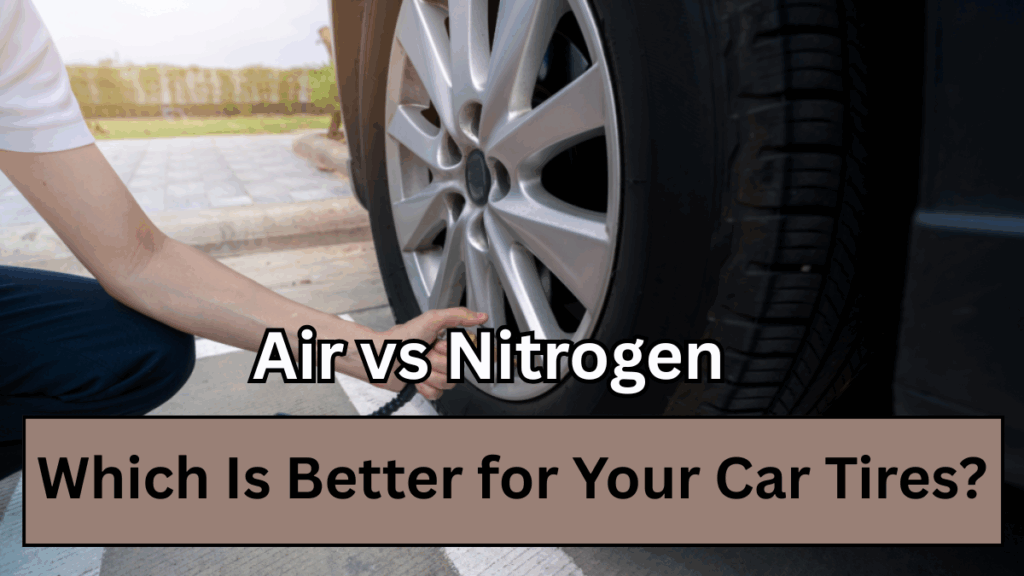When it comes to keeping your car running smoothly, tire maintenance often gets overlooked. But did you know that the type of gas you use to fill your tires can impact your driving experience and tire longevity? The debate of air vs nitrogen in tires has been around for years — so what’s really better for your vehicle?
Let’s break it down in a simple, human way.

Table of Contents
Why Does the Type of Tire Inflation Matter?
Tires aren’t just rubber donuts — they’re high-tech components that play a huge role in safety, fuel efficiency, and performance. That’s why it’s important to understand the difference between using regular air and pure nitrogen.
The Basics: Air vs Nitrogen in Tires
Feature |
Regular Air |
Nitrogen |
|---|---|---|
Composition |
~78% nitrogen, 21% oxygen, rest moisture/CO₂ |
93%–99% pure nitrogen |
Cost |
Usually free at fuel stations |
Usually comes with a fee |
Pressure Stability |
Fluctuates with temperature |
More stable in temperature swings |
Moisture Content |
Contains water vapor |
Dry, reduces oxidation and rust |
Availability |
Widely available |
Limited to specific service centers |
Benefits of Nitrogen in Car Tires
While air gets the job done for most drivers, nitrogen does offer some clear advantages — especially if you’re looking for long-term performance and safety.
Here are some notable benefits of nitrogen in car tires:
-
Improved tire pressure retention
Nitrogen escapes slower than oxygen, meaning you’ll have to refill less often. -
Enhanced fuel efficiency
Stable tire pressure means your engine doesn’t have to work as hard. -
Reduced tire wear
Properly inflated tires wear more evenly and last longer. -
Less oxidation inside the tire
Nitrogen is dry and doesn’t carry moisture, reducing the risk of internal corrosion. -
Improved performance for high-speed or fleet vehicles
Especially useful for race cars, heavy-duty trucks, and aircraft.
Tire Safety Tips You Shouldn’t Ignore
No matter what gas you choose, following these tire safety tips can go a long way in ensuring a smooth and safe ride:
-
Check your tire pressure monthly
Even nitrogen-filled tires can lose pressure over time. -
Look for wear and tear
Uneven wear might indicate misalignment or other issues. -
Rotate your tires regularly
Every 5,000–7,000 miles is a good rule of thumb. -
Keep a tire gauge in your car
It’s a simple tool that can save you money and stress. -
Never mix air and nitrogen without checking
While it’s safe in emergencies, topping off nitrogen-filled tires with air may reduce some of the benefits.
Who Should Use Nitrogen in Their Tires?
Nitrogen might not be a necessity for every car owner, but it’s a smart choice if:
-
You drive long distances regularly
-
You own a high-performance vehicle
-
You manage a fleet or commercial vehicle
-
You live in a region with extreme temperatures
So… Air or Nitrogen? What’s the Verdict?
Here’s a quick side-by-side verdict:
Scenario |
Best Option |
|---|---|
Daily commuting in a city |
Air (convenient & cost-effective) |
Racing, commercial driving |
Nitrogen (stable pressure & performance) |
Living in hot or cold climates |
Nitrogen (less temperature sensitivity) |
Occasional drivers |
Air (sufficient for minimal use) |
In summary:
Air is cheap, easy, and works well for the average driver.
Nitrogen adds a layer of reliability, especially if you want long-term savings and reduced maintenance.
FAQs
1. Is nitrogen really safer than air for tires?
Nitrogen reduces pressure fluctuations and internal moisture, which enhances tire safety — but both options are safe when tires are properly maintained.
2. Can I mix nitrogen and air in my tires?
Yes, it’s safe in emergencies. But for consistent benefits, it’s better to stick to one type of inflation and top up accordingly.
3. Do nitrogen-filled tires improve fuel economy?
Yes, by maintaining better tire pressure over time, nitrogen can contribute to improved fuel efficiency.
4. Is nitrogen worth the extra cost?
If you prioritize tire life, performance, and fewer pressure checks, then yes. For casual city driving, regular air will suffice.
Final Thoughts
In the battle of air vs nitrogen in tires, there’s no one-size-fits-all answer. But understanding the differences and advantages can help you make a smarter decision — one that enhances both your driving experience and tire safety.
Still unsure? Start by checking your owner’s manual or consult your mechanic for tailored advice.
Click here to learn more
